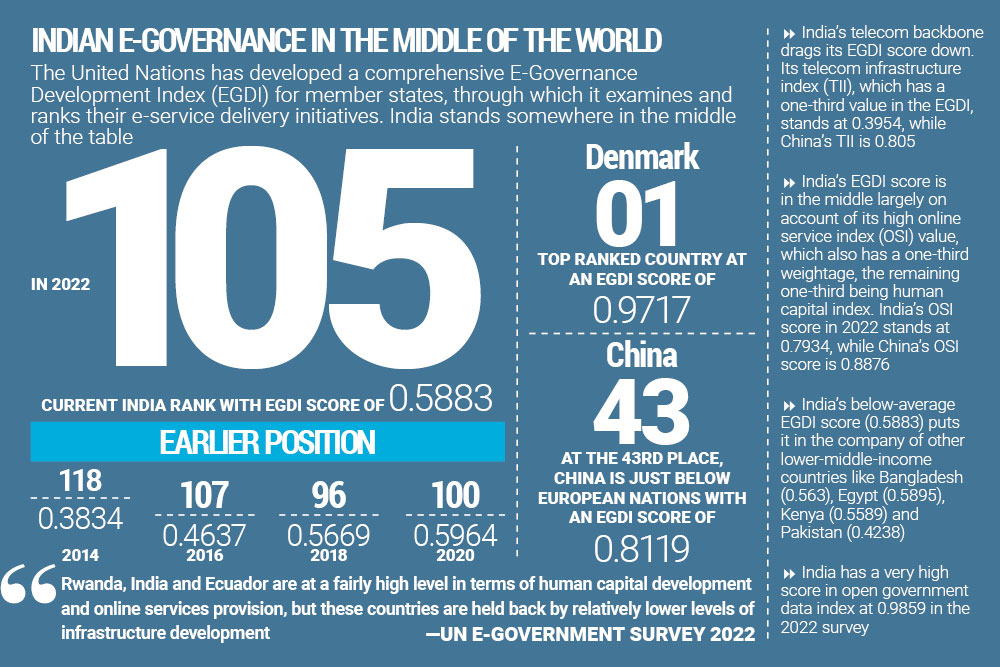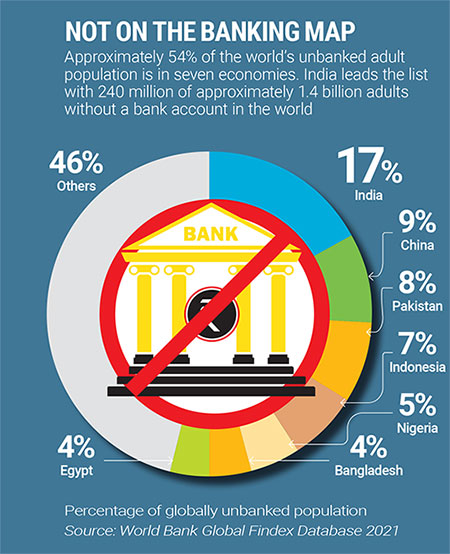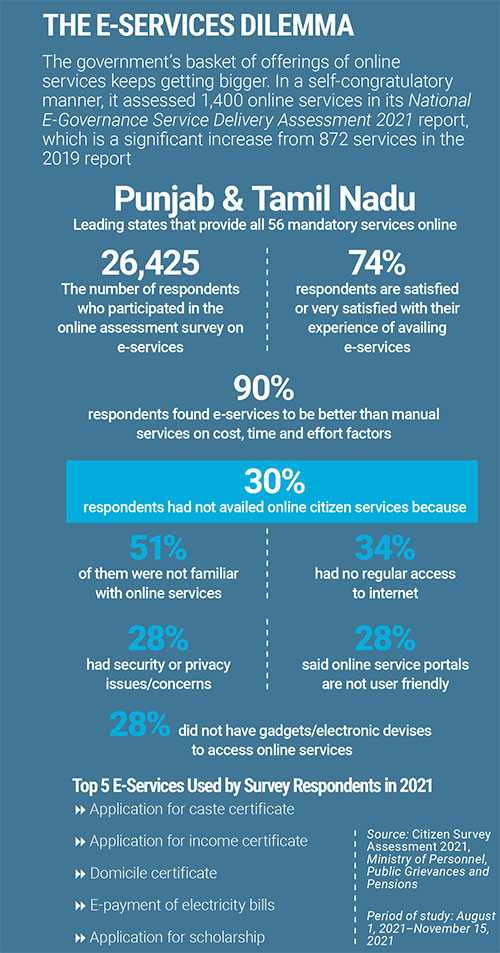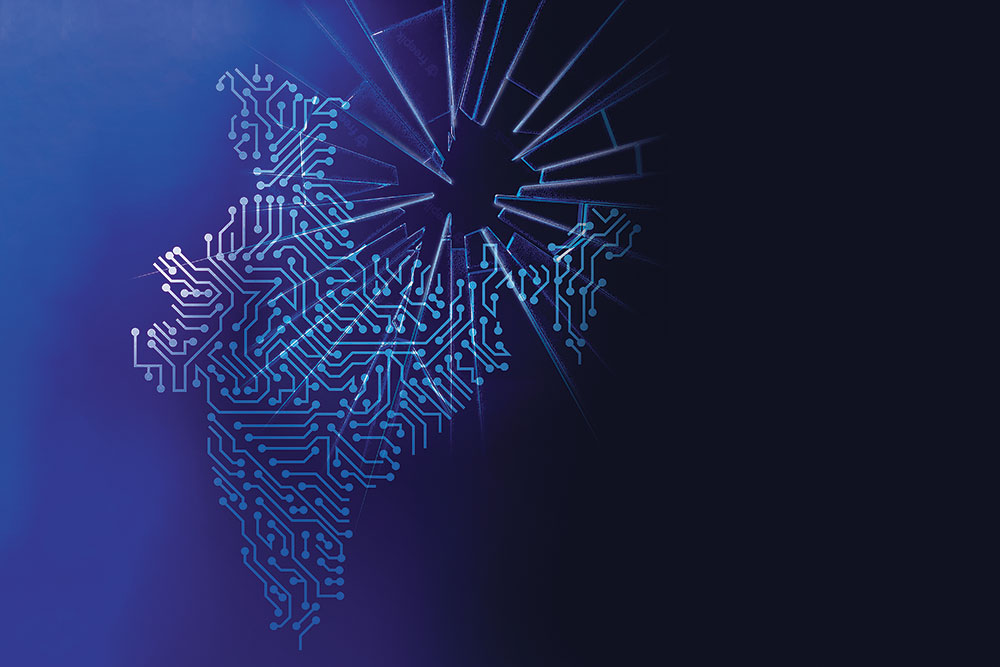In the middle of August 2021, when Covid-19 protocols were still in force, Delhi chief minister Arvind Kejriwal went to a regional transport office (RTO) in the city and put a big lock on its gate. He proclaimed RTOs to be redundant government offices in a digital age and said that most service applications submitted to RTOs will be done in a “faceless” manner online. Through this act, Kejriwal, arguably the country’s second most effective political communicator, was symbolically speaking with the youth of an information and tech economy.
Unaware of Kejriwal’s plans, Khushboo Akhtar, a 31-year-old independent journalist based in Delhi, had already used the Delhi government’s portal to book an appointment at the concerned RTO to obtain a learner’s driving license. When she reached the RTO at the stipulated time, which was a few weeks before Kejriwal’s action, she found a lock outside the office and many bewildered applicants standing there. Clearly, no applicant had been informed that the Delhi government had been phasing out RTOs.
As is a common sight outside government offices, that RTO also had its share of agents or touts, who were willing to help Akhtar for a fee. However, she chose to pay heed to the advice of the policeman on duty, who told her to opt for the faceless application after a few days.
The Delhi government’s website directed her to Parivahan Sarathi, a website created by the Union Ministry of Road Transport and Highways, where she was made to pay again—she was earlier made to pay the government fee before booking an appointment for a physical test. After she made the payment, the website triggered its face recognition algorithm and asked her to sit still in front of her laptop camera, to which she duly complied. But, when she sat in that position for more than 10 minutes and nothing happened, a message flashed on the screen: “Maximum 10 attempts for face authentication. After that applicant needs to visit RTO office.”
Thus ended her rendezvous with a digital India. Though she was disappointed that she was not told how she would get refund for both payments, the whole exercise left her amused. “When the chief minister has already locked all RTO offices, what will I do at the RTO office?” she asks. More pertinently, she asks, “Why was I asked to pay the money to the transport department before my face was authenticated by the website algorithm? Would it not have made more sense for the website to first authenticate my identity and then send me to a payment gateway?”

Akhtar’s brother Nadeem, who accompanied her to the RTO, has a perceptive take on the issue. He says, “India has become a huge data laboratory, where we are all bits and bytes being crunched by unruly and verbose algorithms of the government and global agencies, which are slowly acquiring a Frankenstein-like character.”
The National API
The jury is out and will be out for some time on whether an aspirationally digital India has a giant superstructure of tech blueprint or it is just a patchwork of codes created by agencies—government, non-governmental, corporate and global—which are trying to port their modules to a mythical national application programming interface (API). Akhtar’s experience could be considered a glitch in the superstructure or the mood swings of the mythical soft-machine.
If anything that comes close to being a superstructure in India’s digital journey, it has to be the Aadhaar super-identity card. The country took some time to wake up to its mammoth blueprint, including the debate around privacy issues associated with a database that stores the biometric information of every citizen of the country. The size of the project could be gauged from the fact that then prime minister Manmohan Singh had appointed Infosys co-founder Nandan Nilekani as the first chairman of the Unique Identification Authority of India (UIDAI) with a cabinet rank after some talk between Nilekani and Rahul Gandhi had taken place for the former to join the Union cabinet as human resource development minister.
Incidentally, Narendra Modi as a challenger to Singh had criticised Nilekani and Aadhaar as a “political gimmick with no vision” at an election rally in Bengaluru in April 2014. The prime minister of the country changed after this speech and Nilekani had already become a full-time politician, but the importance of Aadhaar continued in the new scheme of things. In 2014, the new government under Modi allotted about Rs 2,000 crore to the Aadhaar project, thus ensuring policy continuity, highlighting its importance for a digitised India and proving that after the political posturing is over, things stay the same.

The Aadhaar project also proves that when the government decides to push a policy on the ground, it is capable of doing so despite its reputation to be embroiled in red tape. Rajeev Chandrasekhar, Union minister of state for electronics and information technology, told Parliament that till June 30, 2022, the UIDAI had covered 93% of the population and the number of live Aadhaar cards stood at 127.79 crore in the estimated population of 133.58 crore in 2022.
Aadhaar-Enabled Welfare Governance
Per se, the Aadhaar project is only a citizen identification method, but its evolution and alignment with policy measures at the state and Central levels across the Singh and Modi years have made it the digital backbone of the country. The UIDAI started a basic yes/no authentication service in 2012 and at the close of FY13 had completed 24 lakh authentication transactions. In FY21, this figure jumped to 1,413.4 crore transactions. Cumulatively, from FY13 to FY21, this figure stood at a whopping 5,423.51 crore. In 2013, the UIDAI launched an e-KYC service, whose cumulative transaction figure from FY14 to FY21 stands at 908.63 crore.
Despite the nominally voluntary nature of Aadhaar, the government has been pushing its adoption both in private and public sectors. Both Singh and Modi governments have claimed direct benefit transfers (DBT) to beneficiaries of Central schemes as great success, which are built on the Aadhaar project and the National Payment Corporation of India. The government claimed that in FY22, it disbursed Rs 6,30,264 crore in about 717 transactions across the country under different schemes.
The irony in government numbers is that it makes no attempts to capture the user unease in engaging with digital services. Digital welfare services are meant to cater to the lowest strata of society which mostly cannot operate independently and needs an intermediary to access government services.
Ever since the Aadhaar and the NPCI’s Unified Payments Interface (UPI) projects have taken hold, a new acronym, JAM, has entered the bureaucratic lexicon. It stands for jan-dhan from the jan-dhan bank accounts, Aadhaar and mobile. It is common knowledge that, unlike in developed countries, India has low desktop penetration on account of a large lower class and low literacy levels. India’s internet usage exploded due to the popularity of cheap feature phones and smartphones. Understandably, the policymaker is gung-ho about mobile phones. However, there is a catch here. The catch of the intermediary.
One-Way Digital Highway
A World Bank survey on financial inclusion captures the dichotomy of the government’s mega DBT numbers and the last-mile user’s inability to go digital without help. The survey found that in 2021, 77.5% of all respondents had an account with a bank or a formal financial institution, but only a meagre 6.6% reported that they could use mobile banking without external help (this number, however, rose to a handsome 56.5% among people who had a mobile banking account). Moreover, only 27.6% people reported having access to the internet.
These figures indicate the success of DBT-based schemes as a one-way national highway on which information flows from New Delhi to the poor. The reverse or multi-directional flow seems years away.
The Rangarajan committee on financial inclusion predates setting up of the Aadhaar project by a year. In 2008, former Reserve Bank of India governor C. Rangarajan defined financial inclusion for times to come. He wanted “timely and adequate credit at an affordable cost” for the large masses in the country. The Aadhaar project was to be the first stepping stone in that direction, at least in theory.
The World Bank survey quoted above says that 44.8% of its respondents borrowed money, while only 12.8% did so from a formal banking or financial entity, while just 1.7% did so using a mobile money account. It shows that most people who need credit use non-formal ways to access it and mobile-based solutions—the M of the fashionable JAM—are the last option.
Seema Prem, CEO and co-founder of financial inclusion platform FIA Global, says, “Most attempts in digitising financial inclusion focus on traditional ways of digitising supply side factors, wherein the demand side factors are mostly ignored. Fintech is filling the gap left by traditional financial systems, especially in the supply or access side. This includes access to digital infrastructure, efficiency and level of competition in the financial sector, but the path is long and drawn.”
Prem is by and large enthusiastic about the digital inclusion efforts India is making. However, Aneesh Kumar Mansoori’s experience shows how the digital blueprint can affect people at the grassroots. A farmer in the Palasunder village of Madhya Pradesh’s Mandla district, Mansoori has three bank accounts. However, all his social entitlements from the government are credited in only one account, which seems to be a feature of the JAM doctrine. He says, “I have lost control over how I spend the grants I receive from the government. I have a loan and the bank deducts its share the moment the government makes a deposit.” He says that he has tried changing the bank account for receiving his entitlements from the Kisan Samman Nidhi, Mahatma Gandhi National Rural Employment Guarantee Act, etc. to have a better control over his finances, but they continue to be credited to the same account.

Digital Governance Deficit
Researchers Meghna Bal and Vivan Sharan discuss a puzzle of e-governance interventions in their book The Dazzle of the Digital, noting that there is “the State’s unwavering commitment to them despite a limited track record of success”. The Indian politicians and policymaker wanting to appear tech friendly is not a new phenomenon and cuts across party lines. Right from the days of then prime minister Rajiv Gandhi, who ushered in a tech policy, Chandrababu Naidu, who is known to have created a tech hub in Hyderabad, to Modi, the modern Indian leader wants to be seen as a technocrat. The situation on the ground, however, does not justify the hype the political class builds.
Bal and Sharan find an explanation for this gap in what they call technological solutionism. They say, “While digital offers distributional efficiencies, it also creates new exclusions that the state does not necessarily account for. This is because historically there was always a focus on technological solutionism rather than holistic design of state interventions. Technological solutionism assumes that technology has all the answers. But without good programmatic design, the question sought to be answered sometimes becomes secondary.” Consequently, they argue, there is suboptimal consideration of ground realities, such as the limited capabilities or sense of agency of the beneficiaries receiving state support. They feel that the policymaker asks the public sector to ensure that a given technological apparatus or tool is deployed, rather than focussing on how it is used.
The government, though, has given itself a self-congratulatory appraisal. Last year, the Ministry of Personnel, Public Grievances and Pensions published the National e-Governance Service Delivery Assessment report, in which it evaluated 1,400 e-services across states and union territories and found Punjab and Tamil Nadu to be the leading states in offering the maximum number of mandatory e-services at 56. In an online citizen survey the ministry conducted of 26,425 respondents, it found 69.6% of them to have used e-services and 74% of them rated their experience as satisfied or very satisfied.
Jagdish Mitra, chief strategy officer at Tech Mahindra, finds the e-governance in India to be progressing well. He says, “From using ICT for elections, conducting census and computerising all government offices to align with digital lockers, e-Kranti portals, e-Panchayat system and e-Seva Kendras, India is making strides in the field of e-governance.”
It is easy to be impressed with India’s performance on paper when its e-governance delivery is compared with the record in previous years, since the bar is low. Global comparisons do not paint an entirely optimistic picture though. In the UN E-Governance Survey 2022, India’s global rank is 105 with an e-government development index (EGDI) value of 0.5883. Denmark continues to top this table with an EGDI value of 0.9717, while China stands at the 43rd spot with a score of 0.8119. India has moved up 13 places since 2014 in this table when it stood at 118th spot with a score of 0.3834.
According to Mitra, any digital intervention’s success rate is linked directly to change management initiatives. Quoting from the 2018 UN survey, he says that while Denmark is the top-ranked country in online service delivery, which saw about 89% of its citizens using e-services, other countries are struggling. He says, “In Egypt, for example, the uptake of e-services is just 2%. Awareness and education of citizens, application of the right branding, change management levers and timely and effective execution of policies are important [to improve the situation].”
Disappointed Start-Ups
The UN EGDI data captures another important aspect about how India goes about engaging citizens in the delivery process. Its delivery rollout mechanism is high and on the upper side in the global table despite it being a lower-middle-income country. The EGDI measures it with the sub-index online service index (OSI), which has a one-third value in the EGDI. In 2022, India’s OSI was 0.7934.
Vijay Pratap Singh Aditya of the Ekgaon Group, which takes digital and financial services to rural India, especially among farmers, feels that it is not enough to have a top-down rollout of digital services without setting up complementary processes that create a derivative service economy. He says, “True digital service delivery is about efficiency, saving time, removing service bias and direct-to-home delivery. However, the reality in India is different. While the front end of most services is digital, a lack of back-end integration of systems, data, analytics and processes means that the claims about the desired outcome are only a lip service to the cause in the name of creating digital dividend.”

Aditya says that the government has no clear policy on how to iron out back-end creases and involve other organisations and companies in creating a better service-delivery model. It is a known fact that multinational consulting companies are driving the e-governance projects all over the world and India is no exception to the rule. Without a clear policy, the space for start-ups in India’s digital service delivery model is rather constrained. Amit Mishra, co-founder and general partner at venture capital firm 3to1 Capital, says that all stakeholders will have a lot to gain if the government revisits its love for large companies. He says, “Given their small operational scale and inherent business agility, start-ups can offer customised services and products much faster than larger enterprises can. Moreover, start-ups rely more on automation rather than human intervention. Bigger companies with hundreds of engineers on their benches prefer the latter model as they can make more money on per-hour billing.”
After the huge success of the UPI model, digital players expect the government to adopt the open API model more proactively, including for delivery of public services, but there is disappointment writ large. The commercial fintech segment can be called a derivative of the UPI system, but when it comes to public services, the stakeholders feel let down. Aditya says, “Financial inclusion, for example, was meant to use digital to enable access, which it has. However, a lack of data and business and data models have prevented financial service providers to give customised services to the otherwise underserved people, be it insurance, mutual funds, savings or credit access solutions.”
Mishra makes a similar argument and says that while the scope for cohesion and collaboration between public sector agencies and start-ups is immense through an open API model, some use cases did not work out earlier due to a lack of usable data and information being shared in an unsystematic fashion. He says, “The biggest failures in technology adoption is the whole Digital India campaign where, though technology companies ask government departments to go completely digital, they continue to use physical documents.” He adds that the government’s tendering process is not start-up friendly since the data centre costs and other privacy-related terms make it difficult for companies to do business with it.
Bal and Sharan say that divergence in the nature of datasets obtained through government agencies working independently of each other creates a problem of coordination, and giving a unified response where direct public intervention is needed, like it happened in the case of managing Covid-19, becomes difficult. They feel that the government response to Covid-19 was divided on political lines, with the Bharatiya Janata Party governments and opposition governments creating their own apps and tech responses, thus creating fragmented datasets and making disease surveillance difficult. “The problem with a response that is fragmented along political lines is that it frustrates remote surveillance efforts. With so many digital applications, many of which carry out similar functions, datasets were splintered and fragmented. Reports indicate that the limited Centre-state coordination and a lack of trust meant that data was not shared, largely for fear of leakage of politically sensitive Covid statistics,” they say, adding, “We certainly do not have a blueprint for implementation of public schemes through digital services.”
The e-governance assessment report acknowledges the gaps in the service delivery model it practises when it says, “Of course, more services do not automatically lead to better e-Governance. In India, digital literacy and accessibility have been significant challenges and governments have been working hard to address such issues.” As perfunctory as it may sound, it highlights the problem in a country like India. The other two components of the UN EGDI, telecommunications infrastructure index and human capital index, had the values of 0.3954 and 0.5761 respectively, showing where the gap between the government’s intent and the situation on the ground lies.
Digital literacy, after all, is a form of literacy and the government’s digital accountability towards its populace is accountability of another kind. On both counts, there is a lot of work left to be done in India irrespective of whether the space is digital or not.
—With input from Chitra Nair











 Just one email a week
Just one email a week